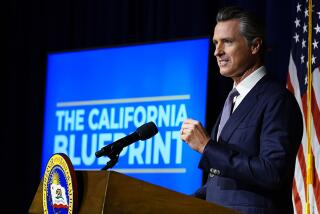THE BUDGET PROCESS
- Share via
SACRAMENTO — Introduction of the governor’s budget proposal Friday--something required by Jan. 10 each year by the state Constitution--is the beginning of a lengthy process that is supposed to result in adoption of a budget by July 1, the start of the new fiscal year. Here is a step-by-step guide to the process:
January. The proposal is introduced separately in the Senate and Assembly, usually by the chairman of the Senate Finance Committee and the Assembly Ways and Means Committee.
February. Those fiscal committees usually take no action until late February, to allow the state legislative analyst--the Legislature’s nonpartisan fiscal adviser--time to review the proposal.
March-April. Budget subcommittees in the Senate and Assembly conduct independent hearings on spending proposed for areas including health, welfare, labor, government services and prisons.
May. The state Department of Finance offers its final estimates of revenues for the coming fiscal year to the budget subcommittees.
May. Subcommittee reports are collected by the Finance Committee and the Ways and Means Committee and incorporated into separate versions of the state budget adopted by the full committees.
June. Budgets are adopted by the two houses by required two-thirds majorities. Differences are worked out in marathon sessions of a two-house conference committee, which is working under the pressure of a June 15 deadline for the Legislature to adopt a final spending plan, a deadline missed more often than it is not.
The compromise version of the budget is adopted by the two houses, again on two-thirds votes.
The Legislature sends the budget to the governor, who has 12 working days to sign it. The governor can veto any individual line item appropriations that the Legislature has added to his proposal, but he cannot restore proposals that the Legislature deleted. The Legislature, by a two-thirds vote, can override the vetoes.
More to Read
Get the L.A. Times Politics newsletter
Deeply reported insights into legislation, politics and policy from Sacramento, Washington and beyond. In your inbox three times per week.
You may occasionally receive promotional content from the Los Angeles Times.










